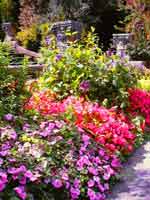



Custom Search
|
|
"People will not look forward to posterity who never look backward to their ancestors." Quotes Shops Ireland Bunús na Gaeilge Did You Know? Himself/Herself Write to Us Readers Write.. Links/Link to Us Advertise with us Awards & Testimonials |
Good Friday Haircuts and Seaweed for Dinner Several other superstitions and customs were associated with the day: •A child born on Good Friday and baptized on Easter Sunday was said to have the gift of healing. If it was a boy, it was expected that he would enter the ministry and attain a high position in the church. •If a person should die on Good Friday and was buried on Easter Sunday, he or she was sure of immediate entry into Heaven. •Eggs laid on Good Friday were marked with a cross and each member of the family ate one of these on Easter Sunday. Eggs set to hatch on this day were said to produce healthy birds. •No one would move house or begin any important business. •No blood could be shed which meant that animals or birds could not be slaughtered. •No one could work with wood or burn it, and no nail could be driven. • No fishing boats went to sea, and all fishing nets or lines were left idle. On the east coast, boats in the harbor would be left lying towards the quay wall and, in coastal communities everywhere, the residents gathered shellfish and edible seaweed which they ate as their main meal. The Gaelic for this “shore food” is bia tragha. From 12 noon until 3 pm, the three hours that according to tradition, Jesus hung on the cross, silence was observed, and families gathered together to meditate and pray. It was expected that the sky would darken. In fact, dark, dreary, cold and wet weather was welcomed as a sign that nature was in mourning for the Saviour, too. Many people went to the church and it was the custom to remove one’s shoes before going inside. Families also visited the graveyards to pray for the dead and many people went to pray at holy wells. After going around a well a certain number of times on their bare knees, they would often take some of the water home with them because it was believed that if it was drawn on Good Friday, it had the power to cure illnesses. When I was growing up, we'd be home from school and it was the custom in our family to attend church and “do the stations” between 12 noon and 3 pm. In the Roman Catholic religion, the stations are a pictorial rendition of the events that took place as Christ carried the cross to Calvary. It was such a very solemn occasion that, even as children, we knew we had to be on our best behavior. My parents also observed a strict Lenten fast. I can’t recall them eating anything during the day and all my brothers and I were offered was hot tea without milk or sugar and dry toast. However, there was one special treat that was reserved for Good Friday evening: Hot Cross Buns! They’re not an Irish tradition, but they were so popular throughout the British Isles, my mother relented and bought one for each of us. Decorated with white, lemon flavored frosting in the shape of a cross, the insides were a rich, yeasty-tasting sweet bread filled with plump raisins; dipping one of these into black tea was a vast improvement over dry toast! Hot Cross Buns! Hot Cross Buns! We explore the customs associated with Holy Saturday in Easter Saturday and a Funeral for a Fish. Resources: The Year In Ireland by Kevin Danaher. |
 Ilnacullen, Co. Cork - an Island Garden Ilnacullen, Co. Cork - an Island GardenLocated in the sheltered harbour of Glengarriff in Bantry Bay. Ilnacullin, which means island of holly, is a small island known to horticulturists and lovers of trees and shrubs all around the world as an island garden of rare beauty. |
||||||
|
|
||||||||
| All contents copyright © 2001 through 2011 inclusive - all rights reserved. March 4, 2011 |
Rollover button Images: Wedding LaRose, Kids Reading & Kitchen Apples and Tea from All Posters prints. The information provided on this site is offered as-is, without warranty. This site's owners, operators, authors and partners disclaim any and all liability from the information provided herein. Any trademarks or registered trademarks on this site are the property of their respective owners. |
This Web Site Bashed, Kicked & Glued together by Russ Haggerty. |
||||||